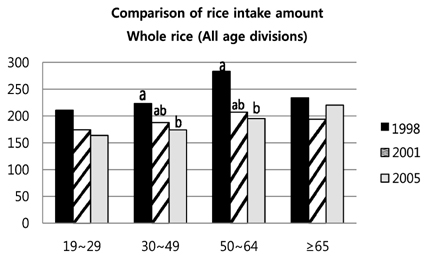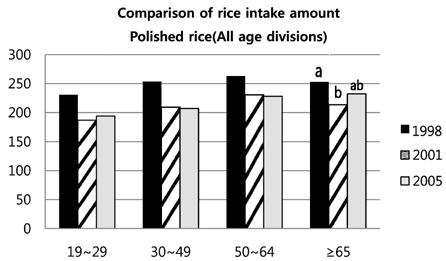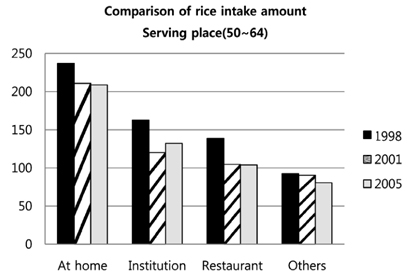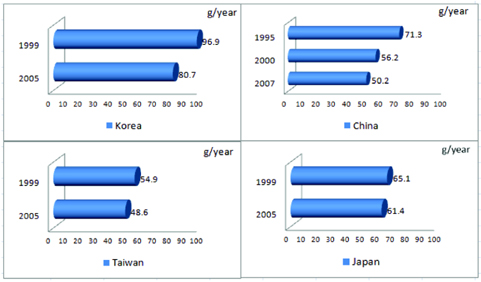Nutr Res Pract.
2012 Jun;6(3):254-262.
A study on the trend analysis regarding the rice consumption of Korean adults using Korean National Health and Nutrition Examination Survey data from 1998, 2001 and 2005
- Affiliations
-
- 1Creative Culinary Institute of Korea, 303 Cheonjam-ro, Wansan-gu, Jeonju 560-759, Korea. angiechung@hanmail.net
- 2Department of Global Korean Culinary Arts, Woosong University, Daejeon 300-718, Korea.
Abstract
- The objective of this study was to provide information regarding trends of rice consumption of Korean adults based on different meal types. Respondent reports 24-hour recall data from the Korean National Health and Nutrition Examination Survey were used to assess daily rice consumption and intake ratios of rice for different meal types and places of preparation. Rice intake had gradually decreased from 224.6 g in 1998 to 190 g in 2001 and to 179.4 g in 2005. The rice consumption of Korean adults decreased every year in all ages for all places of meal preparation in 2001 and 2005 compare to 1998. Analysis for each meal type showed that rice intake at breakfast had not considerably changed, but rice intake had decreased at lunch and dinner. While the rice consumption ratio at lunch and dinner decreased, it also decreased or did not change at snack times except for the 19-29 age groups. All the age groups revealed comparable change in the analysis for meal types. There was some diversity between all age divisions in daily rice intake depending on place of meal preparation. The rice consumption by place of meal preparation was generally highest at home, lowest at other places, but it decreased in all places. The rice consumption at home was highest in the over 50 age group, lowest in the 20-30 age group. These changes seem to be related to food intake patterns of rice and substitutional foods in the diets and development regarding socio-economic status. So the need for further study on differences in rice intake based on socioeconomic levels and age group are indicated.
Keyword
MeSH Terms
Figure
Reference
-
1. Hong TH, Kim KY, Kim CR, Seo JK, Oh CH, Jeong YJ. New Food Materials Science. 2011. Paju: Jigu Publishing Co..2. Slavin J. Whole grains and human health. Nutr Res Rev. 2004. 17:99–110.
Article3. Moutou C, Brester GW, Fox JA. US consumers' socioeconomic characteristics and consumption of grain-based foods. Agribusiness. 1998. 14:63–72.
Article4. Koh-Banerjee P, Rimm EB. Whole grain consumption and weight gain: a review of the epidemiological evidence, potential mechanisms and opportunities for future research. Proc Nutr Soc. 2003. 62:25–29.
Article5. van de Vijver LP, van den Bosch LM, van den Brandt PA, Goldbohm RA. Whole-grain consumption, dietary fibre intake and body mass index in the Netherlands cohort study. Eur J Clin Nutr. 2009. 63:31–38.
Article6. Batres-Marquez SP, Jensen HH, Upton J. Rice consumption in the United States: recent evidence from food consumption surveys. J Am Diet Assoc. 2009. 109:1719–1727.
Article7. Albertson AM, Tobelmann RC. Consumption of grain and whole-grain foods by an American population during the years 1990 to 1992. J Am Diet Assoc. 1995. 95:703–704.
Article8. Sakamoto S, Hayashi T, Hayashi K, Murai F, Hori M, Kimoto K, Murakami K. Pre-germinated brown rice could enhance maternal mental health and immunity during lactation. Eur J Nutr. 2007. 46:391–396.
Article9. Galvin MA, Kiely M, Flynn A. Impact of ready-to-eat breakfast cereal (RTEBC) consumption on adequacy of micronutrient intakes and compliance with dietary recommendations in Irish adults. Public Health Nutr. 2003. 6:351–363.
Article10. Statistics Korea [Internet]. 2009. Daejeon: Available from: http://kostat.go.kr/.11. Korea National Health and Nutrition Examination Survey Report. Ministry of Health and Welfare [Internet]. 1998. Seoul: Ministry of Health and Welfare;Available from: http://knhanes.cdc.go.kr.12. Korea National Health and Nutrition Examination Survey Report. Ministry of Health and Welfare [Internet]. 2001. Seoul: Ministry of Health and Welfare;Available from: http://knhanes.cdc.go.kr.13. Korea National Health and Nutrition Examination Survey Report. Ministry of Health and Welfare [Internet]. 2005. Seoul: Ministry of Health and Welfare;Available from: http://knhanes.cdc.go.kr.14. Lee JS, Kim J. Vegetable intake in Korea: data from the Korean National Health and Nutrition Examination Survey 1998, 2001 and 2005. Br J Nutr. 2010. 103:1499–1506.
Article15. Choi MK, Hyun WJ, Lee SY, Park HJ, Kim SN, Song KH. One portion size of foods frequently consumed by Korean adults. Nutr Res Pract. 2010. 4:82–88.
Article16. Zheng Z, Henneberry SR. An analysis of food grain consumption in urban Jiangsu province of China. J Agric Appl Econ. 2010. 42:337–355.
Article17. Flood VM, Burlutsky G, Webb KL, Wang JJ, Smith WT, Mitchell P. Food and nutrient consumption trends in older Australians: a 10-year cohort study. Eur J Clin Nutr. 2010. 64:603–613.
Article18. Ryu HK. A comparative study on the nutrient content of rice-based and wheat-based meals in Miryang and Daegu. Korean J Community Living Sci. 2003. 14:47–57.19. Kim YO. Changes in health status with the changing patterns of rice consumption among Korean. Food Ind Nutr. 2008. 13:15–21.20. The results of researching grain consumption at households in Korea. Statistics Korea [Internet]. 2009. cited 2009 Oct 15. Daejeon: Available from: http://kostat.go.kr/.21. Goodwin HL Jr, Holcomb RB, Rister ME. A study of Asian-American rice demand in Houston, Texas. J Food Distrib Res. 1996. 27:41–47.22. Hartini TN, Padmawati RS, Lindholm L, Surjono A, Winkvist A. The importance of eating rice: changing food habits among pregnant Indonesian women during the economic crisis. Soc Sci Med. 2005. 61:199–210.
Article
- Full Text Links
- Actions
-
Cited
- CITED
-
- Close
- Share
- Similar articles
-
- Risk of Metabolic Syndrome according to Intake of White Rice and Kimchi in Korean Adults: based on the 6th Korea National Health and Nutrition Examination Survey, 2013–2015
- Analysis of intake trends of kimchi, fruits and vegetables (1998–2020) and factors associated with the intake (2016–2020): based on the Korea National Health and Nutrition Examination Survey
- Moderate Alcohol Consumption Does Not Prevent the Hypertension among Korean: the 2001 Korean National Health and Nutrition Examination Survey
- Trends in energy intake among Korean adults, 1998-2015: Results from the Korea National Health and Nutrition Examination Survey
- Analysis of Kimchi, vegetable and fruit consumption trends among Korean adults: data from the Korea National Health and Nutrition Examination Survey (1998-2012)










